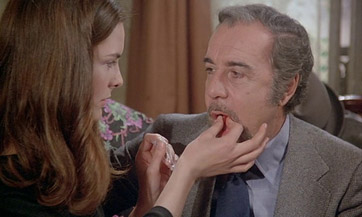Sole Criterion: That Obscure Object of Desire
By Brett Ballard-Beach
June 7, 2012
“Got me a movie, I want you to know.”
DVD Spine #143/Laserdisc Spine #113 (both out of print)
I am currently reading In One Person, the latest novel by my favorite living American author, John Irving. Written in the first person (like about every other of his novels), its narrator is on the brink of turning 70, as Irving himself did earlier this year. What I find notable about this novel, especially when taken in tandem with his previous book, Last Night in Twisted River, is Irving’s increasing focus on characters that are, to turn an underutilized epithet, life-sized.
This is in contrast to the larger-than-life figures that populate everything from The World According to Garp to The Hotel New Hampshire to A Prayer for Owen Meany. The familiar Irving archetypes are still present and accounted for, and yes, another faculty member is lost to a frozen wintry death after slipping on an icy patch after an evening of drinking, but there is a strong current of the elegiac, as well as a tamping down of the youthful rambunctioness that had an easy capacity for spilling over into grotesquerie. (A vivid example, even though it comes from Irving in his early 50s, was 1994’s A Son of the Circus, a supremely unpleasant and seamy tale. I punished myself by reading everything except the 50-page epilogue and then never looking back).
Artist, author, filmmaker and charter member of the surrealists Luis Bunuel was born at the dawn of the 20th century and released what proved to be his final film, That Obscure Object of Desire, in 1977, as he eased into his late 70s. Irving published Garp the following year. I hesitate to draw too fine a line connecting their styles or themes, but watching the film for the first time since a theatrical screening about seven or eight years ago, and with the new “softer” Irving fresh in my mind, it helped me see some parallels among aging artists who maintain their vitality and creativity (and to an extent their rage) and reflect it through the creative prism that only can be realized from living long enough to keep honing and perfecting one’s art.
I have seen only a small number of Bunuel’s films, but when I was an adolescent I was in love with the idea of them, particularly The Exterminating Angel and The Discreet Charm of the Bourgeoisie, the former with its dinner guests simply unable to leave the house of their host after their meal and the latter with its protagonists forever sitting down for repast and suffering a severe bout of gourmand interruptus for their troubles. It wasn’t until I was an adult that I finally had a chance to see two of his most notorious creations, 1929’s Un Chien Andalou and 1930’s L’Age D’or, a pair of collaborations with Salvador Dali that strung together shocking images in the service of attacks on hypocrisy (religious, sexual, financial, and otherwise), and succeeded in giving the still new art movement of Surrealism a cinematic calling card.
Continued:
1
2
3
4




